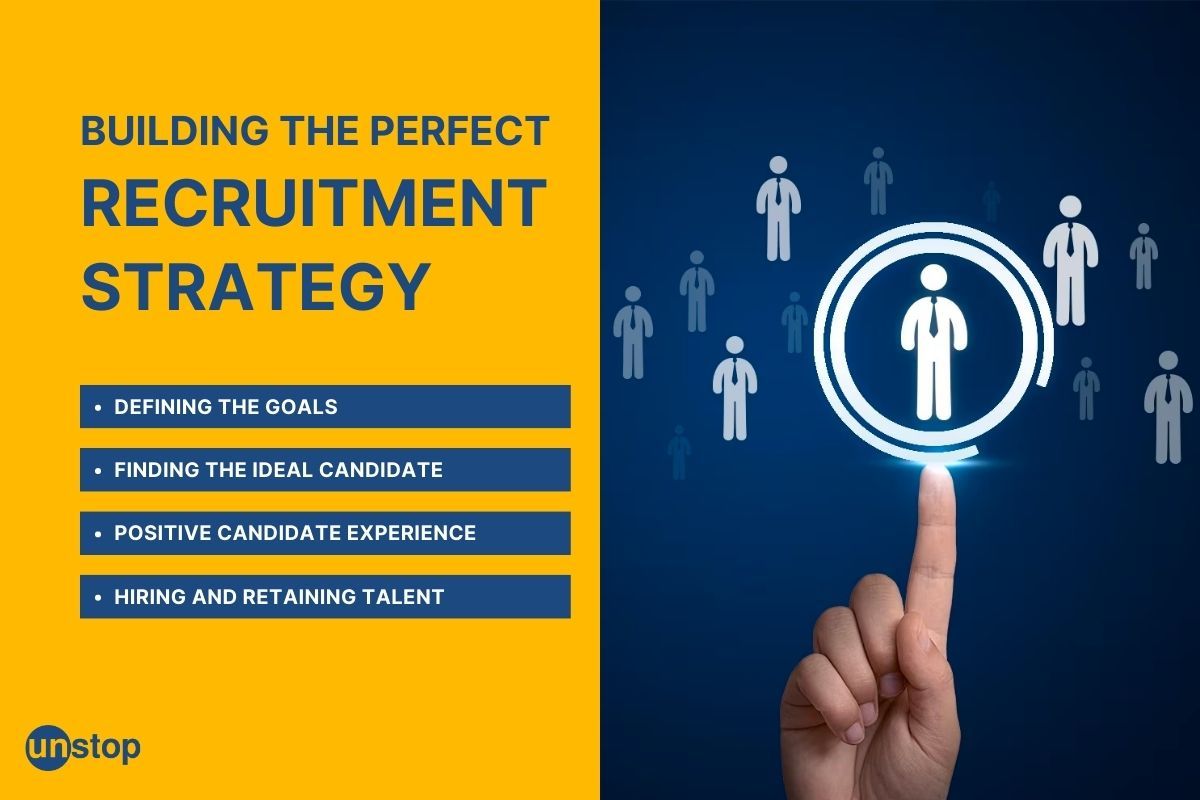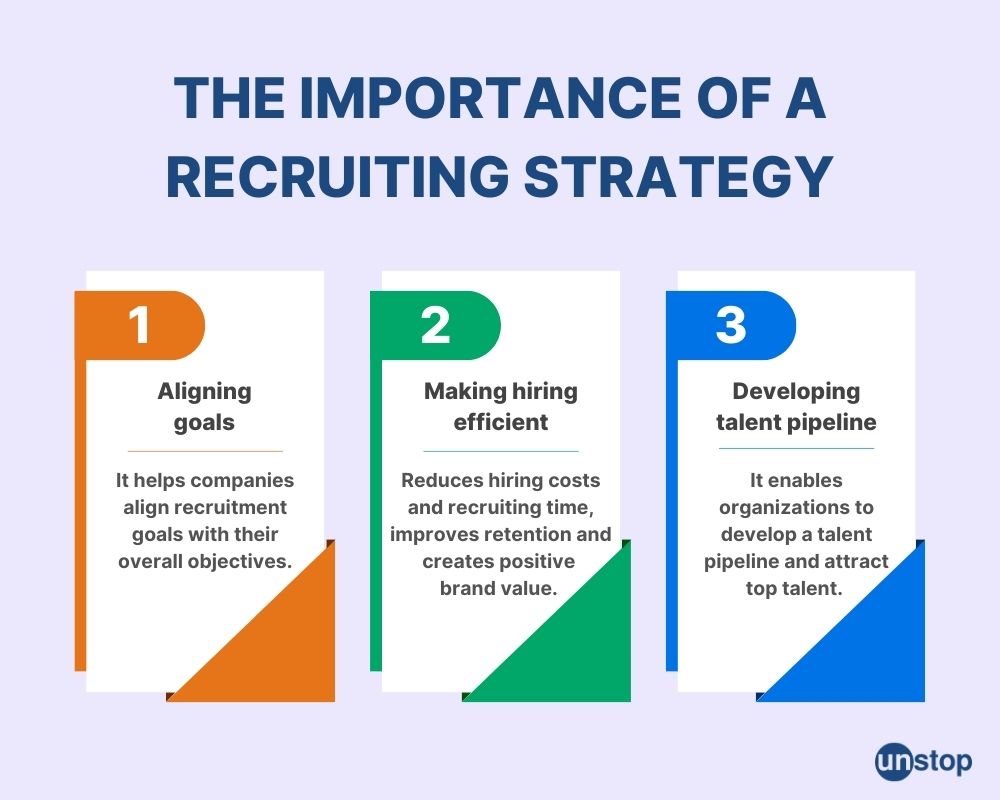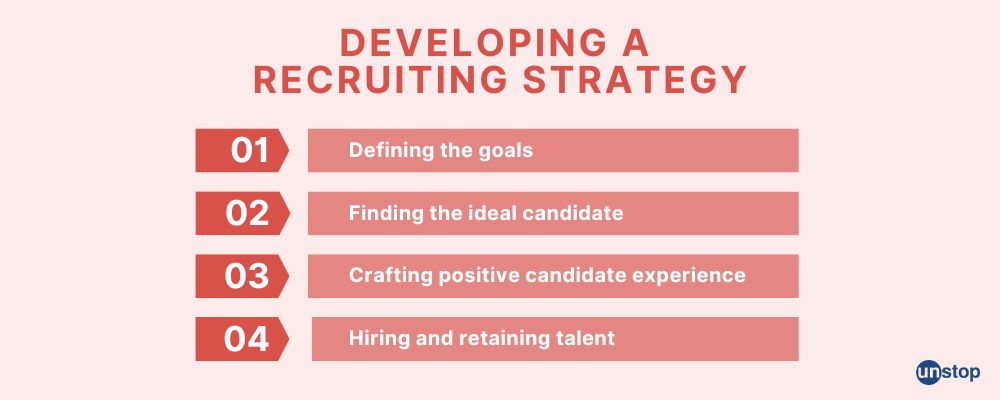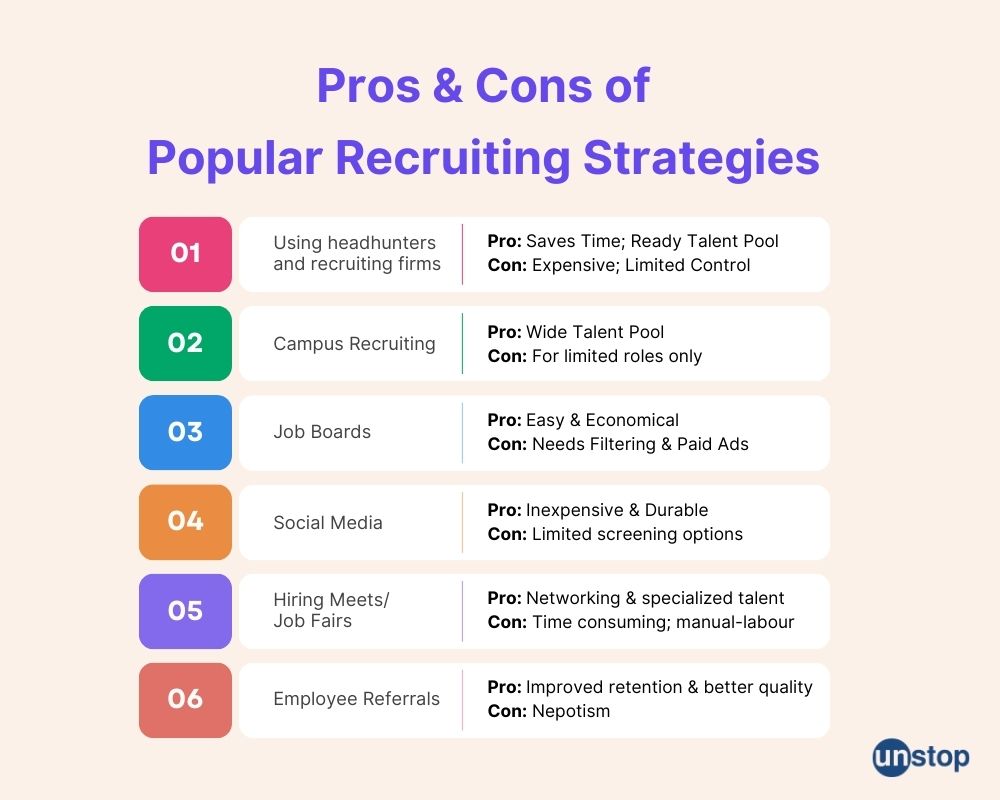- What's A Recruitment Strategy?
- Developing A Winning Recruitment Strategy
- Recruitment Strategies Everyone Should Know
- Popular Recruitment Strategies: Pros & Cons
- Creative Recruitment Strategies For Common Challenges
- How To Improve Your Recruitment Strategy?
- Frequently Asked Questions
A Detailed Approach To Developing A Winning Recruitment Strategy

Recruitment is one of the core business functions, essential for the smooth running of any organization. Recruitment is instrumental in all stages of a company's lifecycle and thus, it's critical to have an effective recruitment plan in place.
People often believe that hiring qualified candidates for a vacancy is an easy process that starts with job postings and ends with an offer letter. However, it's not that easy or simple. And if you have this viewpoint, then you're also missing about 20 additional, important steps in the recruitment process.
What does that mean? It means you don't have an effective recruitment strategy in place - because you've failed to identify the stages of recruiting.
The recruiting process starts with identifying, attracting, assessing, and hiring qualified candidates, and ends with retaining them. During the process, it also focuses on improving employer branding.
A proper recruitment strategy focuses on the entire process and helps organizations improve their hiring practices to make better decisions.
What's A Recruitment Strategy?
A recruitment strategy is a detailed plan of action that helps organizations (or their recruiting teams) identify, source, assess and hire potential candidates to find the best talent for a role. It helps recruiters define the role, identify ways to source potential candidates, and define the criteria for assessing and hiring them.
Among other things, a recruitment strategy should include information about the current recruitment process, headcount of current employees, ways to attract potential candidates (recruitment marketing), employee value proposition, budget for recruiting, selection criteria or assessment framework, and software or tools being used.
A recruitment strategy can cover the entire recruiting process. But, organizations can also implement various strategies for parts of the recruiting process. For example, developing sourcing strategies in recruitment.
Organizations employ various recruiting strategies, depending on their end goal. For example, an organization may develop a strategy to deal with high turnover rates. However, the end goal should be in line with the overall company objectives.
For any recruitment strategy to be successful, it's important that organizations identify the end goal, use a combination of techniques to implement the strategy and always, always measure the end results to evaluate effectiveness.
Why is it important?

Having a well-planned recruitment strategy in place can have several benefits for an organization, but the biggest advantage is that it helps directs recruitment efforts to a well-defined, achievable goal with a proper plan of action.
Here are some of its other benefits:
i) Aligning recruitment goals with the company's objectives: Recruiting is not a standalone function. Having a strategy in place helps companies align recruitment goals with the overall objectives, ensuring that one function (recruiting) supports other functions (sales, marketing, growth, etc.), rather than hampering them.
ii) Making the hiring process more efficient - A highly efficient hiring process reduces hiring costs and recruiting time, improves retention and thus, the company's overall performance, and contributes to creating a positive brand value.
iii) Developing a talent pipeline: Human resources are the most important asset of any organization. Sourcing strategies in recruitment are a core part of the overall strategy. Thus, an effective recruiting strategy enables organizations to develop a talent pipeline and attract top talent.

Developing A Winning Recruitment Strategy
By now, it must be clear that organizations use recruiting strategies to find suitable candidates. While every strategy is personalized according to the end goal, there are certain core elements that must be present.
These are: having an end goal in sight, evaluating current practices and results; focusing on the overall impact, and being flexible in your approach.
Pro Tip: Flexibility is a core element - at every stage of the recruitment process, recruiters should be open to adapting and innovating, depending on the actual scenario unfolding in front of them. A rigid approach to recruiting can hamper the effectiveness of the process and lead to losing out on high-quality candidates.
The Four Stages Of Building A Recruitment Strategy

Let's now understand what goes into each stage of a recruitment strategy:
1. Define the goals
The first step of building any strategy, including one for recruiting, is defining the goals. The end goal could be company growth. In this case, organizations could be looking to increase manpower through campus recruiting, which gives access to a large volume of candidates in one location. If, on the other hand, the goal is to hire for a hard-to-fill role, a targeted recruitment strategy could work.
This stage also includes assessing the current organizational strategies and finding loopholes, setting a budget, defining the key metrics to measure, and ensuring the recruitment goal aligns with the overall objective.
2. Use the 3S of finding the ideal candidate
The 3S of finding an ideal candidate refers to strategies for sourcing, screening, and shortlisting candidates to find the right fit for the role.
Recruiters should adopt a strategic bent of mind when sourcing candidates - adopting a mix of common and creative sourcing channels. They should also use innovative and effective screening methods. Lastly, shortlisting should be done on pre-defined criteria. And reasons for shortlisting a candidate should be clearly specified.
Tips to source, screen and shortlist quality talent:
- Job Postings on appropriate channels (job boards, company career page, professional networks, etc.)
- Develop employee referral programs
- Harness the power of social media and make your job descriptions SEO-friendly
- Focus on recruiting videos, especially for campus hiring
- Don't miss out on passive candidates or niche job boards
- Use applicant tracking systems to streamline the process
Pro Tip: Use recruitment automation to speed up the process, reduce costs and eliminate hiring bias (unconscious bias) or collaborate with an experienced hiring platform.
3. Crafting A Positive Candidate Experience
A positive candidate experience is a salient part of an effective recruiting strategy, that has long-term benefits for the organization. It goes a long way in influencing a candidate's decision to reject or accept the offer - especially if you're a new organization or don't have a strong employer brand.
From basic hygiene checks (testing assessment tools in advance, aligning time and place for interviews, etc.) to new-age solutions, organizations can use different approaches to create a positive candidate experience.
Here are some tips to improve the candidate experience:
- Create an inclusive job description and application process by making it gender-neutral, easily accessible, and available in multiple languages.
- Gather feedback and from candidates at different stages of the process
- Gamify assessment techniques to improve engagement.
- Involve current employees in the planning and execution
Pro Tip: Everyone on the recruiting team should keep this mantra in mind - treat your candidates like your customers, especially during the interview process. Your interview questions should not feel like an interrogation. Giving potential hires due attention, respect their time and be courteous.
4. Hiring & Retaining Candidates
There is a reason first-year attrition is a recruitment metric. If candidates are accepting the offer but leaving within the first year, it indicates a flaw in the company culture or workplace policies and impacts the overall retention rate. Similarly, if the offer acceptance rate is low or there are multiple dropouts at the last stage of recruitment, it's an indication of a weak compensation structure and poor employer brand. Thus, it's important that the recruitment strategy also focuses on hiring and retaining candidates.
Here are certain tips to keep in mind to reduce dropout and improve retention:
Design an attractive offer package that focuses on both, compensation and complimentary benefits (performance bonus, flexible working hours, period leaves, etc.).
Don't keep applicants waiting unnecessarily i.e., follow-up with applicants in a timely manner. Candidates are likely to interview with multiple organizations simultaneously and may even have more than one offer in hand. Unnecessary delays may lead you to miss out on a worthy candidate.
Have an onboarding plan in place that helps familiarize new employees - you can prepare a toolkit of essential resources, appoint a peer mentor, and an informal networking session.
Build an attractive company culture: A company culture that focuses on transparent communication, values diverse viewpoints, and promotes talent and skill set is one where any new employee will be motivated to work hard.
Don't mislead candidates to just fill the vacancy: Overcommitting or misinforming prospective employees can negatively impact their experience. This can hamper their performance and affect the brand value.
Recruitment Strategies Everyone Should Know

Some of the most common recruitment strategies used by organizations are:
Using Headhunters & Recruiting Firms
Organizations can employ the services of headhunters and hiring platforms or recruiting firms. To do so, firms must clearly specify the skill set (hard and soft skills), experience and qualifications required for the role. Ideally, they can even share the ideal candidate persona that would suit the role and align with the company values.
Campus Recruiting
If the aim is to find a wide pool of candidates, campus recruiting is the way to go - especially if the role you're looking for does not require intensive experience. Through campus hiring, organizations target colleges and final-year students to usually hire for entry-level positions or junior roles in the firm.
Find the perfect campus strategy for all your hiring needs with Unstop's Campus Hiring solutions. Explore here.
Job boards
Job seekers frequently visit popular job boards to look for job openings. Job boards offer the option for free posting and paid advertisements. There are also niche job boards that target a specific pool of talent.
Social Media
The hiring team may even post about job opportunities on social platforms. Social media has become the go-to tool for networking, entertainment and even job search - especially for the younger generation of talent.
Hiring events
Hiring events or job fairs are events where job seekers meet employers. These can be specific to an industry and are a great source to hire for roles that require specialized skills or experience. These can also be organized by professional associations associated with a role - for example, an event organized by ICAI for Chartered Accountants. Such events can also be a valuable networking opportunity - recruiters may connect with candidates and build a talent pipeline of potential applicants for future opportunities.
Employee Referrals
An employee referral program is a great way to connect with passive candidates. Employee referrals also help source candidates who have a better idea about the company culture, which helps improve retention.
Depending on the end goal, companies can opt for either one of these strategies or even use a combination of different strategies.
Popular Recruitment Strategies: Pros & Cons
Every recruitment strategy has several advantages and disadvantages, as listed below:
| Recruitment Strategy | Advantage | Disadvantage |
| Headhunters & Recruiting Firms | Saves time; access to a ready talent pool | Low control over candidate screening; can be expensive |
| Campus Recruiting | Large volume of applications; Hire talent that can grow with the organization | Suitable for limited roles; Candidates may require extensive mentoring |
| Job boards | Easy to post and economical to use | Filtering applications is time-consuming and ads/ boosting job posts may require additional fees |
| Social Media | Inexpensive and durable | Limited agency over filtering applications |
| Hiring Events/Job Fairs | Great way to network and find candidates for specialized roles | Expensive, time-consuming, and requires intense manual labor |
| Employee Referrals | Improved retention and better quality candidates | Risk of nepotism |
Creative Recruitment Strategies For Common Challenges
There are several challenges common to organizations, such as working with a limited budget or hiring for hard-to-fill roles. Given below are tips and strategies that organizations can use in such situations:
Working with a limited recruiting budget
If the recruiting budget is limited then firms need to reduce the cost-per-hire. This can be done by various means - using free job boards to post about vacancies, leveraging social media to attract candidates and promote a role, and engaging with employees virtually, instead of through in-person interviews. Virtual hiring is also usually cheaper than the traditional mode of hiring.
Hiring to increase diversity
The advantages of diversity hiring are manifold. If that's your approach to recruiting, then be sure to use a diverse panel for interviews, build a balanced workforce, proactively attract minorities through niche job boards to correct for bias, and safeguard against unconscious bias through blind hiring, etc.
Hiring for hard-to-fill roles
A hard-to-fill role requires novel recruiting strategies and lesser-known job sources like hiring meets or unexpected social platforms (like Twitter). You can also opt for hackathons or competition-based hiring to make the process more engaging. Lastly, if you're struggling to find the ideal candidate during screening, cast a wider net. This implies recruiting an individual who may not be perfect on paper, but have some of the necessary skills for the role. Sometimes, it can be advantageous to go beyond the resume!
How To Improve Your Recruitment Strategy?: Key Takeaways
There's no fixed formula for crafting a successful recruiting strategy. Since the process involves interacting and engaging with humans, the success of a recruitment strategy can never be predicated with complete accuracy.
But, companies can improve their recruiting strategies by keeping certain key points in mind and following best practices:
i) Build an attractive career page and update it regularly - Organizations should ensure they have a dedicated page where all active career opportunities are listed.
ii) Use recruiting videos - a single video can be used for all job roles. It's a great way to showcase the company culture, especially in the case of e-recruiting or virtual hiring.
iii) Make your applications mobile-friendly and implement SEO: Most applicants use a mobile device to carry out different activities, including job applications. Thus, ensure that your application process is mobile-friendly. Also, use SEO techniques in job descriptions, social media posts, etc. to stand out from the competition.
iv) Answer common questions from candidates: There are several common questions about job openings that all candidates have. These can be clearly answered through a FAQ section on the career page. FAQs about anticipated queries can also be included as part of each job listing.
v) Target Past Candidates: Recruiters should maintain a database of past candidates. These are candidates who may not have been accepted for a certain role but were a good fit for the company. Approaching them for a new role may reduce the time-to-hire and cost-per-hire and improve candidate experience and quality of hire.
vi) Gamify assessment to engage candidates: A tired approach to recruiting and assessment can impact the candidate experience. Gamifying assessment makes it easier to engage with prospective employees. And it's more fun for everyone involved.
vii) Targeted Social Media Recruiting: What's better than social media recruiting? Targeted social media recruiting i.e., using social media in an intentional way by focusing on specific sections of the audience, rather than every person on every social platform (which can be a lot).
viii) Use niche job boards: Use niche job boards with a specific target audience to meet diversity hiring goals or fill hard-to-fill roles. Popular job boards may have a greater user base, but they also have greater competition and standing out from other firms can be expensive and time-consuming.
Frequently Asked Questions
How do you set a recruitment goal?
Here are some basic steps that you can follow to set an end goal for recruitment:
- Audit the current workforce to identify gaps in skill set
- Set a budget and identify potential candidates
- Outline the recruitment process
- Ensure that your goal aligns with the company objective
What are some examples of recruitment strategies?
Some popular recruiting strategies are: Campus hiring, virtual hiring, using headhunters and recruiting firms, hiring meets or career fairs, and using social media and sponsored ads.
What are some methods that can be used to evaluate recruiting?
Organizations can choose various metrics to evaluate the effectiveness of a recruiting strategy. Some of the most common metrics are:
- Time-to-Hire: It tracks the time taken to fill a position, from the time an applicant applies for the role to the time they accept the offer.
- Source-to-Hire: It helps track the percentage of applicants that apply using various sourcing channels. This is an important metric as it allows organizations to understand which source of hire is yielding the best result (in terms of speed, quality of talent, and financial investment).
- Cost-per-Hire: This metric tracks the average recruiting cost by dividing the total cost by the total number of hires.
- Offer Acceptance Rate: This tracks the percentage of applicants who accept an offer from the total number of applicants who received an offer.
- Candidate Experience: It evaluates the overall application experience of candidates.
Suggested Reads:
- A Comprehensive Guide To Diversity Hiring & Why It Matters
- Talent Shortage & 8 Other Challenges Recruiters Face In 2023
- Lateral Hiring: A Complete Guide To The Process, Its Benefits, Challenges & Best Practices
- Lateral vs Fresher Hiring: Which Is A Better Choice?
- Campus Hiring Platform: Why Do You Need It & How To Find The Best One?
I’m a reader first and a writer second, constantly diving into the world of content. If I’m not writing or reading, I like watching movies and dreaming of a life by the beach.
Login to continue reading
And access exclusive content, personalized recommendations, and career-boosting opportunities.
Subscribe
to our newsletter
Blogs you need to hog!

Organize Hackathons: The Ultimate Playbook With Past Case Studies

What is Campus Recruitment? How To Tap The Untapped Talent?

Lateral Hiring: A Complete Guide To The Process, Its Benefits, Challenges & Best Practices













Comments
Add comment